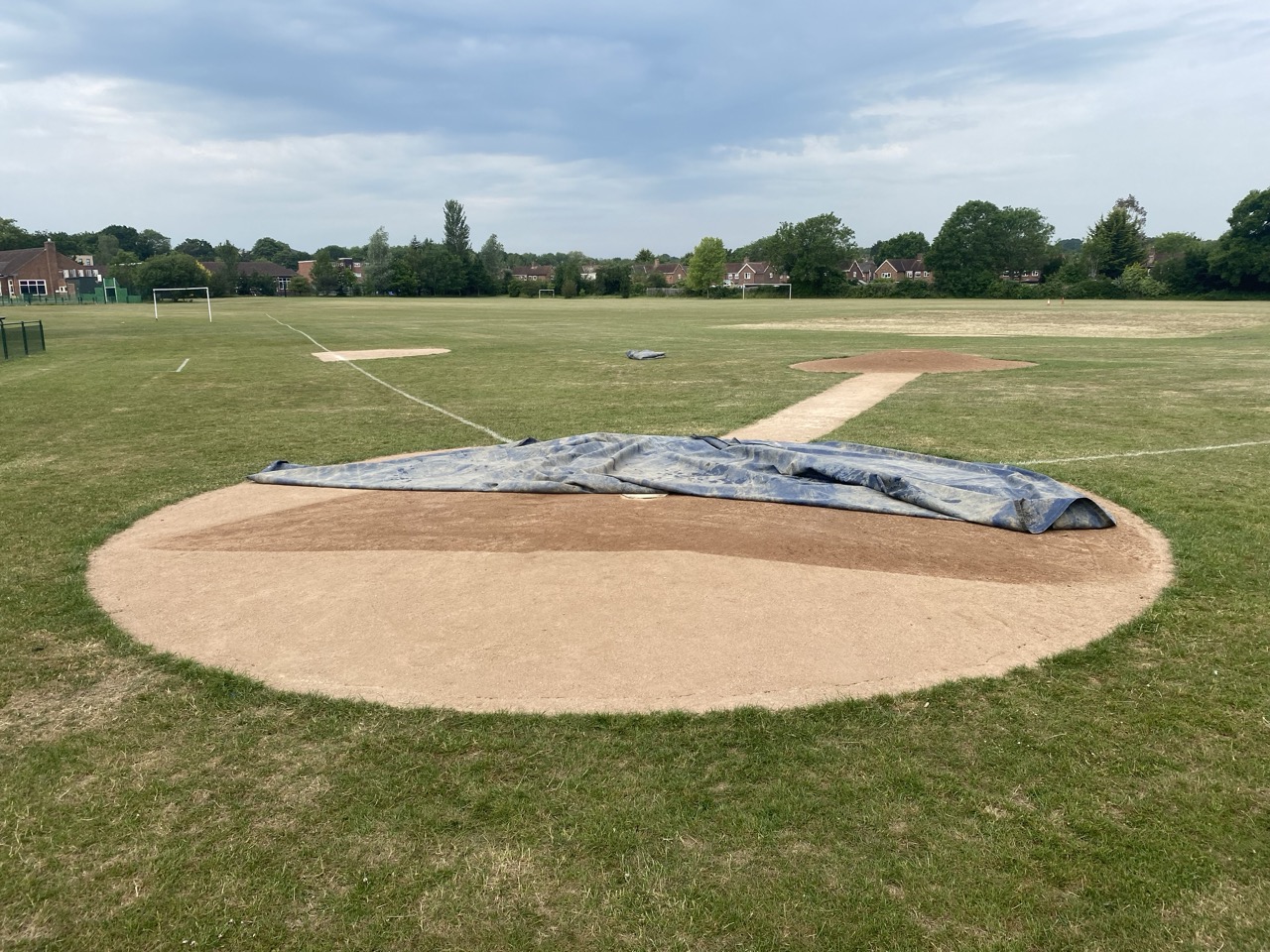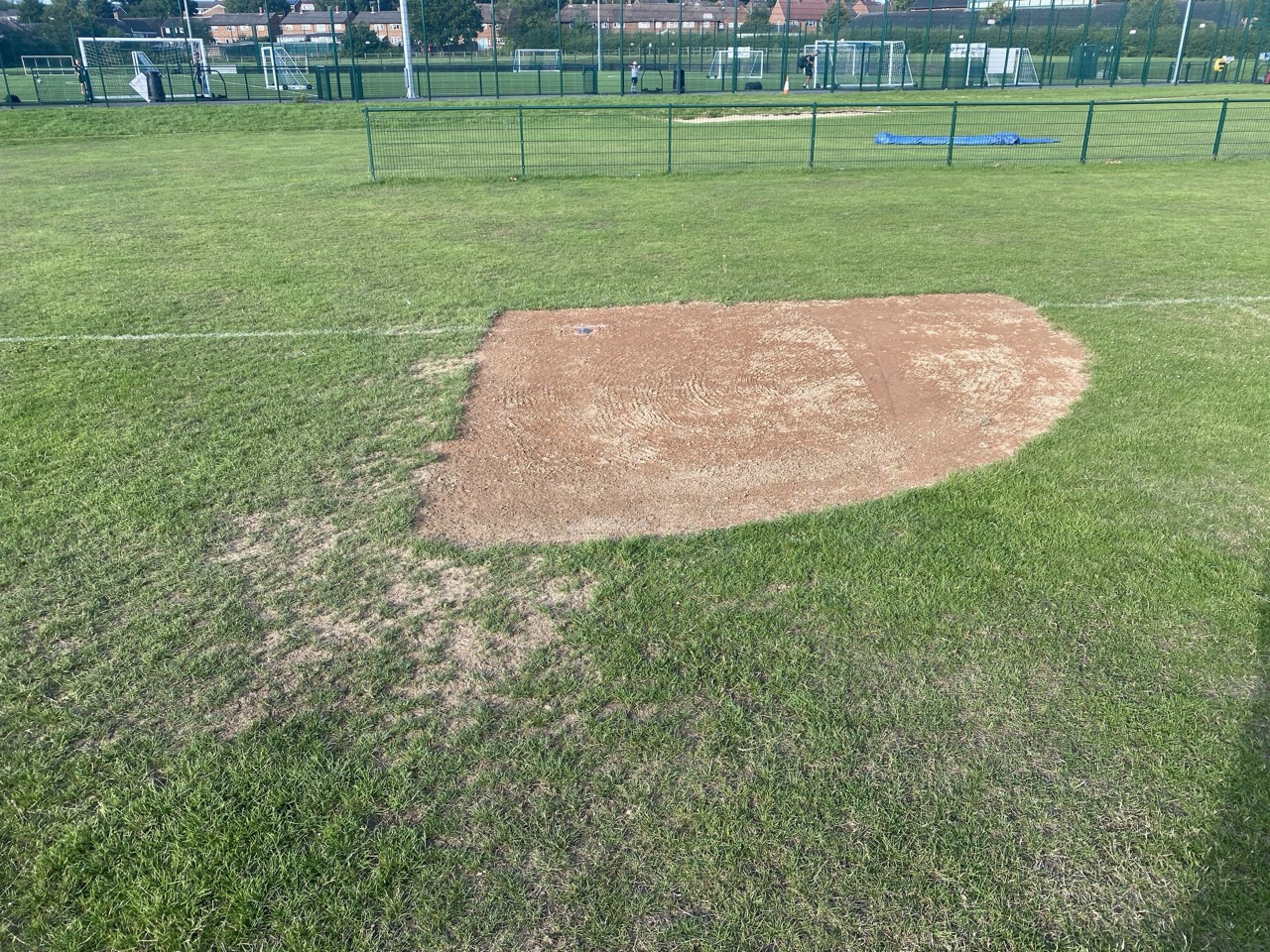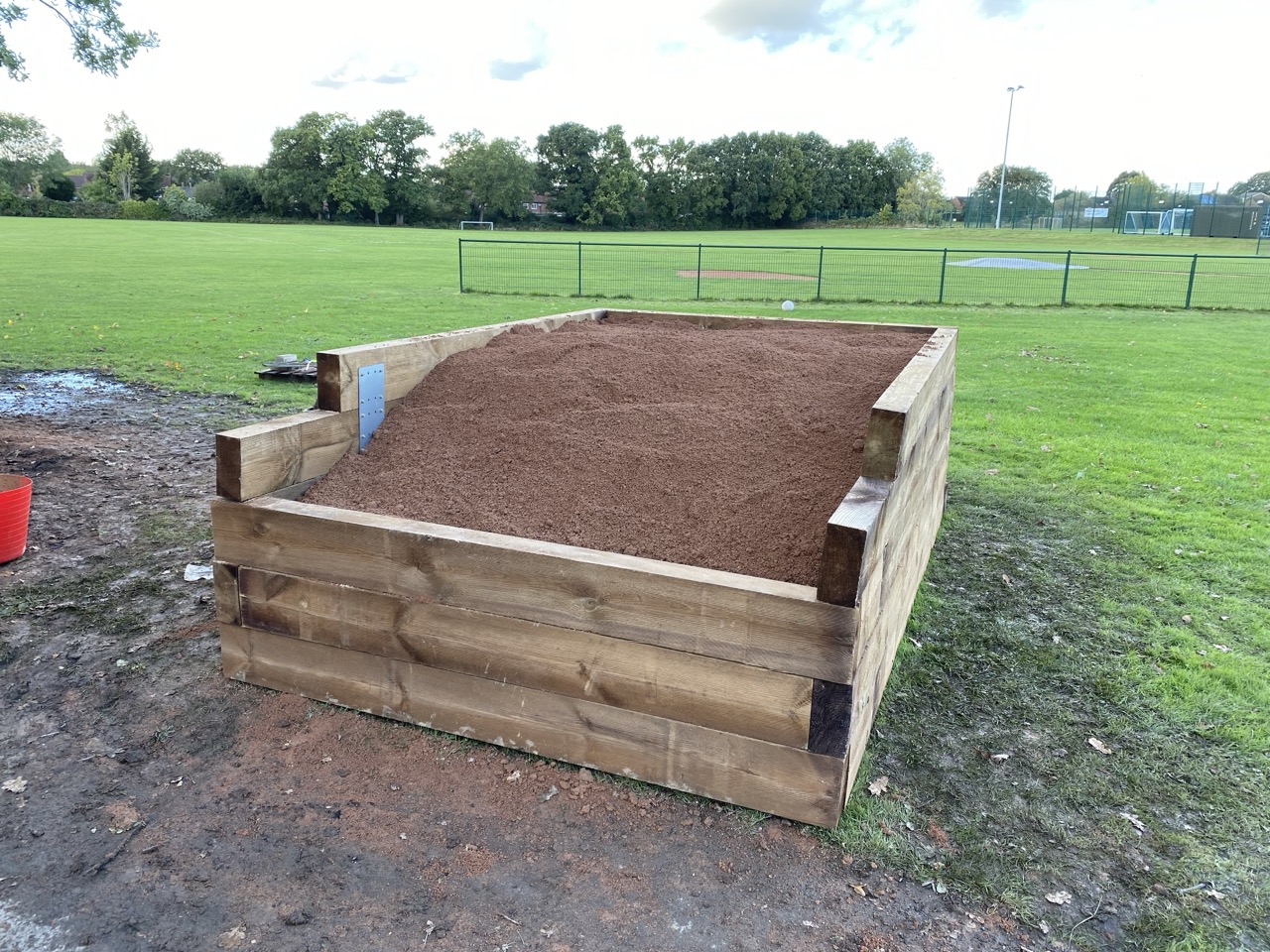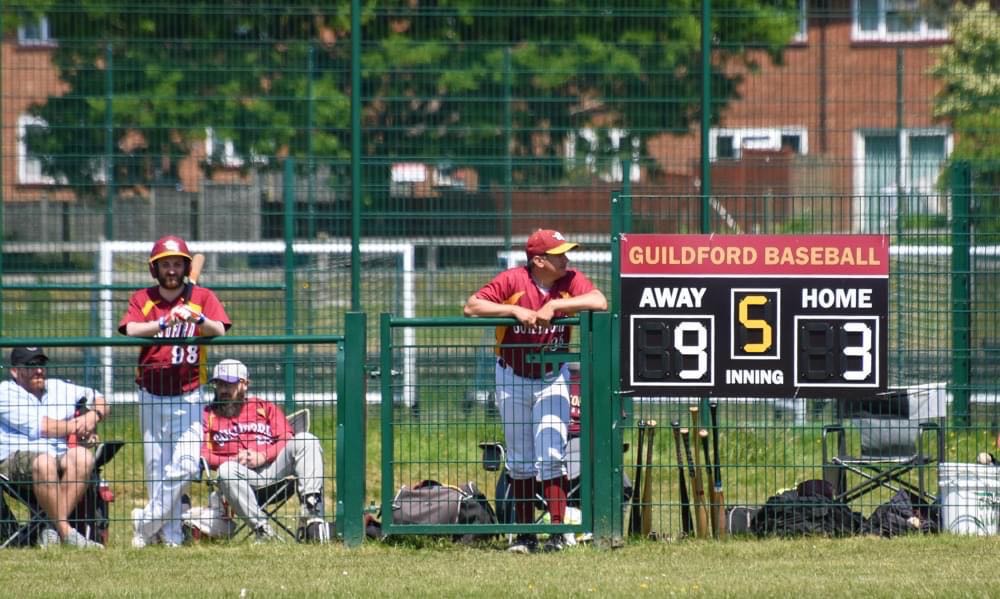The following is an update on lessons we learnt during and after the first season of use (2023) and in preparation for the next season (2024)
The first season of playing at King’s College is now over and we are in preparation for the next. This is what we have learned so far. We always understood that regular maintenance would be required to keep the field at it’s best. Our preparation with the tools was a sound choice and by doing ‘a little, often’ helped keep the field stay in good shape. Leaving things too late, such as strimming the edges or repairing holes simply would have made them worse and more difficult to tackle.
Tarpaulins for the mound and home plate were a wise choice. They were simply held in place by heavy duty tent pegs and (despite a close encounter with a lawn mower) they did their job incredibly well. They were useful in many ways; keeping the moisture in the dirt, keeping the dirt from blowing away, keeping kids and other people off and stopping grass and weeds from growing. We chose not to go for tarps for the bases, partly due to cost and to work as a comparison to see how they fared. You can see from the pictures that the bases held up very well in the end but these had significantly less footfall and use than the mound and home plate as expected. We would definitely recommend tarps for the most used areas. See the pictures of when a tarp became loose from the wind and check the difference in the dirt colour to see how effective they are.
Buying a suitable nail drag proved awkward so we made one which was used an awful lot. The top layer needed to be loosened a little to ensure purchase for cleats, safety for sliding and to help avoid hollows. We always used this before a game and again afterwards. At times the bases were too hard to effectively drag which is where a good soaking of water beforehand would help however, we did not have a reliable source to sufficiently do this. Always drag from outside to inside which will avoid creating a hollow in the centre. The nail drag was never used on the mound as this requires a more delicate touch and it would destroy the table top quickly.
We usually repaired the mound after two game days, more frequently if required. This usually needed an hours work and was easy for one person to complete. The batters (and catchers) boxes lasted a little longer but took a bit longer in the repair. The mound was always the same; the ‘digout’ area in front of the rubber and the landing zone. We used unfired clay bricks for the repair and when they were soft it was easy to sculpt them into position. Once they became dry we smashed them up into rubble and filled the repair areas with that and plenty of water. One or two bricks were used for the digout area and about three for the landing area. Approximately 3-5 bricks were used for each batters and catchers box. Completing this work before training on Thursday was enough time for use on the Sunday, playing too early on softer areas would undo all the effort as there would not be enough time for the new clay to bind with the existing. We also kept the mound for game pitching only.
The grass also needed maintaining. The school had contractors who mowed the main part but they did not get too close to the fence or dirt areas which left a strip of various sizes that had to be mown with a push lawnmower. We also used a strimmer at the fence. This task always took longer than expected and we had to ensure that there were enough charged batteries. For the 2024 season we have purchased a petrol strimmer which is infinitely better in the speed and quality of how it performs. We run it on Aspen fuel which is a bit more expensive than petrol from the pump but is cleaner, lasts longer and does not need to be pre-mixed with oil. The priority was the area at the tall backstop was neat so that balls did not get lost in tall grass.
Keeping the edges of the dirt areas tidy and from getting out of control also needed regular mowing/strimming. This wasn’t as onerous as mowing close to the fence but was crucial in keeping the level of the grass equal to the dirt. If we had left this for too long, lips would have formed which is awkward to repair. Again, little and often stops the build-up of larger problems.
We had to top up the dirt at home plate twice during the season. Each time it took about eight wheelbarrows to get back up to the correct level. The mound always had one wheelbarrow of dirt during repairs and often needed another. The bases held up well and rarely needed filling despite them being open to the elements.
Something we would have probably done differently would be to change the shape of the first base area. We had quarter-circles for the bases but we found that the heavy traffic path where runners would lead-off crept out onto the grass. This gradually killed the grass and always required 
sweeping dirt back from the grass. Making it longer towards second base would simply solve this problem but that is for another day.
We kept the dirt mixture in the bags they were delivered in until the school demanded we create a better storage solution. We don’t blame them as the area was becoming messy however the cost was not welcome. Our solution was to build an area from sleepers which held approximately eight bags. We put a tarpaulin over it held by a ratchet strap which is not perfect although it held out over the winter but we will be looking to improve this.
 Another unexpected task was to make some temporary duckboards for the gates. During the wet start of the season in April and the high traffic area on the two gates required something to avoid making a trench. This was simple enough to do but added an additional expense.
Another unexpected task was to make some temporary duckboards for the gates. During the wet start of the season in April and the high traffic area on the two gates required something to avoid making a trench. This was simple enough to do but added an additional expense.
A positive part of the design was the ‘keyhole’ (the dirt straight section from the mound to home plate). This helped keep the mound from developing a teardrop shape and gave the juniors a dirt area to pitch from. It was also a helpful area for coaches to hit out or throw batting practice. We would recommend this to any club as a practical benefit.
Another success was simply how well the ground fared. We built this field from advice from the baseball community, the internet, along with a little bit of hope. In an ideal world where time and money are no object, levelling the field prior would have been worthwhile. During the building phase we identified an area where the shortstop would field that had a hollow, so we levelled that with dirt and re-seeded. This worked very well, so much so that we have filled in an area near second base during this off-season. We appreciate that this process is far from the desired perfect world but considering the cost of levelling we are content with how this works. All it takes is a few volunteers, spades, wheelbarrows and grass seeds.
On our wish list would be increasing the distance of the 4’ fence, (mainly on the first base side). An extra panel or two would keep the ball in the field of play for overthrows from third base and shortstop.
We are fortunate that our ground is within school grounds and not in a public area. Periodic inspections are useful even if no work is completed. Tarps can become loose, vandalism could occur, things can happen. We visited the ground in mid-February and have already seen the grass creeping higher against the fence so you can imagine what another few weeks will have in store if nothing is done. We had to complete periodic weed killing sprays on the dirt areas but not a lot at all. Be sure to choose the correct solution as selective weed killer won’t kill grass if that begins to creep in.
The scoreboard was a hit. Everyone loved putting the runs on and it stopped the persistent questions of ‘what’s the score?’ and ‘what inning are we in?’ The juniors really enjoyed it.
Pre-season 2024
For the new season we will be ensuring the edges are in order as they will need a little tidying, the dirt levels are correct and the high wear areas taken care of (from last season). The mound rubber will also be turned. It has four edges so we won’t just use the same surface year after year.
We will also be looking to install field ‘carrots’(plastic cones screwed into the field with a coloured tuft at grass level. We will use this for marking the junior field and also the fence to ensure consistency when the team is setting up.
One resource which has been incredibly important in this journey is https://groundskeeperu.com/ This site was created by Beacon Athletics who know everything that needs to be known about ballparks and how to maintain them. The link is a free online course on how to look after a field and is well worth your time if you are interested in the upkeep of a baseball diamond.
Sections
Costs (as of 2021/22)



